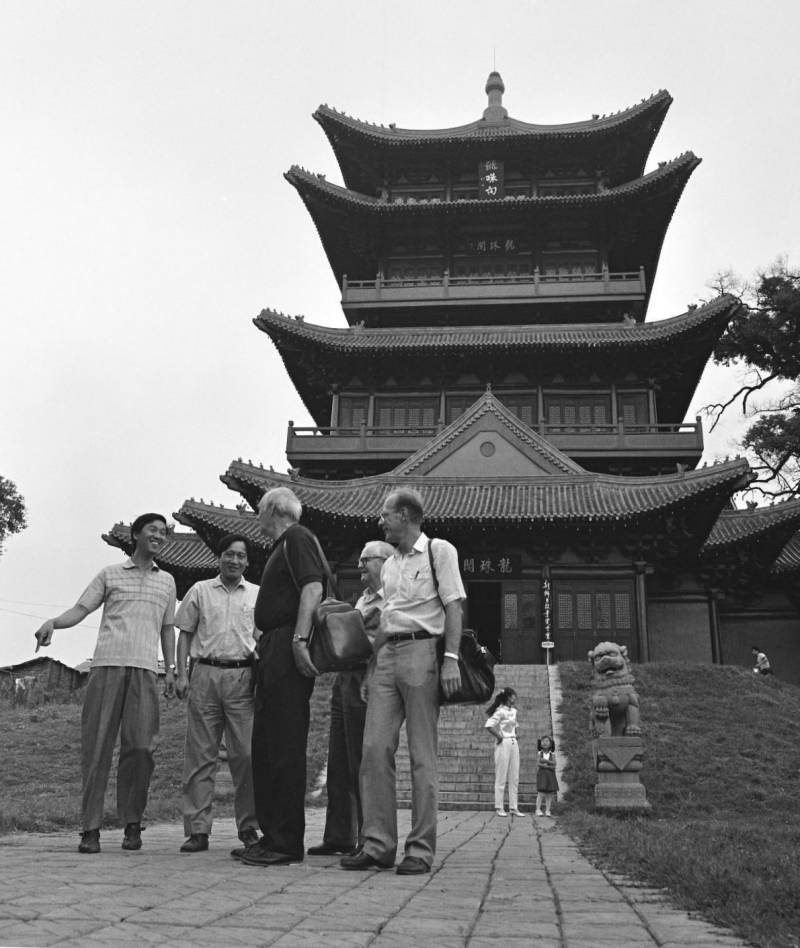

- It's nine meters down to Chenghua.
We are standing next to the Longzhu Pavilion, at Zhushan, the highest point of the former Imperial Porcelain Factory in Jingdezhen. From left to right, Associate research fellow Jiang Jiangxin, Dr Liu Xinyuan, Erik Engel, Professor Bo Gyllensvärd and Jarl Vansvik.
Photo by Jan-Erik Nilsson, Jingdezhen, September 1992
I first had the pleasure of visiting Jingdezhen in early 1991. The trip was quite extensive. It had been planned by Professor Bo Gyllensvärd and a group of passionate friends and collectors of Chinese porcelain. The goal was to explore a wide range of Chinese art history. We visited many places, from Neolithic Banpo, Tang Chang'an (Xi'an), Mongol to Qing Beijing, Ming Nanjing, and Warlord Shanghai. Of course, we also went to Jingdezhen, the historic porcelain capital of China, where we explored the porcelain industry from the Five Dynasties to the Mao era, and the ongoing excavation of the Ming-period Imperial Porcelain Factory at the Zhushan.
During that visit in 1991, we had met Dr. Liu Xinyuan and his team at the Jingdezhen Porcelain Archaeological Research Institute. They were excavating near Zhushan – Pearl Hill – the actual site of the former Imperial Porcelain Factory. We had also got to see a large number of Imperial Ming porcelain pieces reassembled from excavated shards.
The research had uncovered a lot of new facts. We in Sweden felt it was important to stay informed. The best way to do this was to send someone to Jingdezhen to study the finds and report back to those interested in Sweden.
Back in Sweden, we began arranging a study trip for Professor Gyllensvärd, funded by donations. At a ceremony at an antiques fair is Stockholm in the autumn of 1991, a travel grant was presented by a group of sponsors.
During the 1950s, Bo had been participating in an excavation studying ancient Chinese porcelain finds in Fostat, meaning Old Cairo, and we felt that it would be an interesting opportunity for him to some 40 years later round off these studies by visiting the very site of their manufacture.
During a seminar at the Percival David Foundation of Chinese Art in London, in 15–17 June 1992, Bo Gyllensvärd and the head archaeologist Dr. Liu met, and the issue of this upcoming visit was brought up. Dr. Liu immediately let us know, that although he would be traveling most of the time when we planned to be in Jingdezhen, his staff would be there to help us with whatever we wanted to see.
Two friends and fellow collectors, Jarl Vansvik and Erik Engel, and I decided to join Bo Gyllensvärd on this study tour, out of personal interest and at our own expense.
Admittedly, it was with somewhat of a surprise that, three months later, after a long and tiring trip, we were met at the Jingdezhen railway station by a group of enthusiastic young archaeologists and a brand-new white Volkswagen bus, ready to drive us around and help with anything we needed.
Professor Gyllensvärd's own observations from this visit were presented in a talk in London the following summer 1993. The following pages are made up of my own photos, together with pretty much all of my own notes taken down during this visit. None of this have been presented elsewhere in any other format.
I am happy to have got the opportunity to participate in this study tour in such knowledgeable company.
I hope these pages will add to our knowledge of Antique Chinese Porcelain.
In accepting the warm hospitality extended to us, we became deeply indebted to Dr. Liu and his colleagues at the Jingdezhen Porcelain Archaeological Research Institute. It is my sincere hope that we one day may have the opportunity to return their generosity.
Jan-Erik Nilsson
Gotheborg.com
This diary translated and published at Gotheborg.com in March 2014.